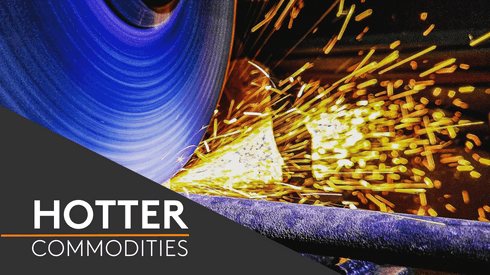Argentina is a key player in the global mining industry, particularly for copper and lithium. These two commodities are crucial for the energy transition, making Argentina’s reserves highly valuable. In our recent webinar, experts from various sectors shared their insights on why Argentina is poised to lead the market and how key players are navigating the country’s unique regulatory landscape.
The speaker line up included: Mariana Plaza, Argentina’s ambassador to the UK, Rob McEwen, CEO, McEwen Mining, José Luis Manzano, president, Integra Capital, Saúl Feilbogen, senior partner, Vitale, Manoff & Feilbogen, Ignacio Celorrio, executive VP, legal and government affairs, Lithium Argentina, James McKeigue, European base metals editor, Fastmarkets, Albert Mackenzie, copper price reporter, Fastmarkets and Callum Perry, strategic markets editor, Fastmarkets.
To watch the full webinar replay, simply fill out the form here.
Read on below to find out the key takeaways from the webinar. Whether you’re an investor, industry professional or simply curious about the future of mining in this region, find out what makes Argentina a powerhouse in the copper and lithium markets.
Argentina’s abundant copper and lithium reserves
Argentina has the world’s third-largest lithium reserves and sixth largest copper reserves. According to Mariana Plaza, Argentina’s Ambassador to the UK, the country is strategically positioned alongside Chile – the world’s largest copper producer – in the ‘cordillera de los Andes’ (the Andes), making it a prime location for mining investments.
Advanced projects in the pipeline
The country boasts around 180 advanced mining projects, with 50 focused on lithium and 32 on copper.
“Capital expenditures in the lithium sector alone exceed $8 billion, with resources estimated at around 70 million tonnes,” said Ignacio Celorrio, executive VP of legal and government affairs at Lithium Argentina.
For copper, the capital expenditure is approximately $17 billion, with resources totalling around 75 million tonnes.
“The potential productivity capacity for copper is projected at one million tonnes per year,” said Rob McEwen, CEO of McEwen Mining. This significant investment underscores Argentina’s potential to become a global leader in mining these commodities.
Regulatory landscape for mining in Argentina
Argentina recently introduced the new incentive regime for large investments (RIGI) scheme, which provides financial leverage for various sectors, including mining.
Saúl Feilbogen, a senior partner at Vitale, Manoff & Feilbogen, said, “Projects with investments worth $200 million or more can benefit from the RIGI scheme.”
This has made Argentina an attractive destination for mining investments. The RIGI scheme offers several tax benefits, such as a reduced income tax rate of 25%, faster amortization periods, and the ability to carry forward losses without restrictions.
“Withholding taxes on exports and dividend taxes are also reduced or removed under the regime,” Feilbogen said. Additionally, companies can bring in machinery and components free of duties and licenses at customs.
The regime provides tax, custom, Forex, and regulatory stability for 30 years. Companies are required to spend 20% of their investment locally, ensuring that the benefits of mining are felt within the country. Any disputes can be resolved through international arbitration panels, providing an added layer of security for investors.
Booming lithium sector
Argentina’s lithium sector has been booming due to its favuorable geological conditions and protective mining rights. “Argentina’s lithium production remains cost-competitive even in a low-price environment,” said Celorrio.
This resilience makes Argentina a reliable source for lithium, essential for electric vehicles and renewable energy storage. Several key lithium projects are coming online, including those by Ganfeng, Posco, Livent and Lithium Argentina. The new regulatory changes benefit both the copper and lithium sectors, making it easier for companies to operate and invest in Argentina.
“These changes are a game-changer for the industry,” said Callum Perry, strategic markets editor at Fastmarkets. “Argentina is not just a mining hub; it’s becoming a critical player in the global supply chain for green technologies,” he said.
Copper sector insights
One of the most significant projects discussed was Rob McEwen’s Los Azules project, one of the top 10 undeveloped copper deposits in the world. McEwen highlighted the project’s potential: “Los Azules is set to become a major player in the global copper market.”
Investment in Argentina’s copper sector is expected to grow, with more companies looking to capitalize on the country’s abundant resources and favorable regulatory environment.
“The potential for growth is immense,” said José Luis Manzano, president of Integra Capital. “With the right partnerships and investments, we can unlock unprecedented opportunities that will not only benefit our industry but also contribute significantly to Argentina’s economy,” he said.
While the opportunities are vast, there are challenges to overcome, including infrastructure limitations and environmental concerns. However, the government and private sector are working together to address these issues, ensuring sustainable growth for the industry.
Copper scarcity and industry outlook
During the webinar, experts underscored the increasing global demand for copper, driven largely by the transition to renewable energy and the growing electric vehicle market. They highlighted that copper is essential for efficient electrical conductivity, making its scarcity a pressing issue.
“As we move towards a greener economy, the need for copper will only escalate,” said Rob McEwen.
Participants discussed the potential supply shortages and the importance of investing in Argentina’s abundant reserves to meet future demand. Addressing this scarcity is vital for ensuring a sustainable energy transition, and Argentina’s strategic initiatives are positioning it as a critical player in bridging this gap.
Watch the webinar replay to find out more
Argentina’s mining sector is on the brink of a renaissance, particularly in the copper and lithium markets. With abundant resources, favourable regulatory changes and significant investments, the country is well-positioned to become a global leader in mining. The insights from our recent webinar highlight the immense potential and opportunities in Argentina, making it an attractive destination for investors and industry professionals alike.
If you’re interested in learning more about Argentina’s mining sector, fill out the form to access the webinar replay. This comprehensive session provides in-depth insights and expert opinions, offering valuable information for anyone looking to explore this burgeoning market.






